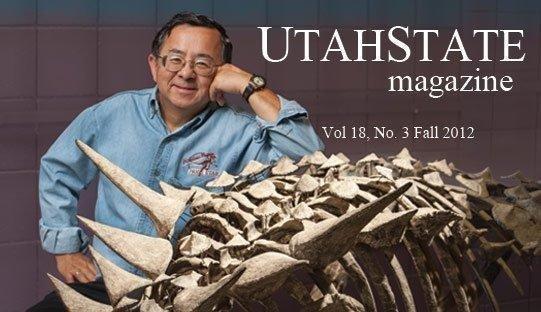From the age of five, when first exposed to the 1956 silver screen thriller, “Godzilla, King of the Monsters,” Dr. Kenneth Carpenter has had a love for dinosaurs. This love developed as he studied at the University of Colorado, Boulder, published 233 scientific papers and discovered a new species, changing the face of paleontology forever.
Dr. Carpenter was branded a prodigy of paleontology as a high school student, when he discovered bones that would later be linked to a giant ground sloth that is now housed in Denver’s Museum of Natural History. Fast forward to 1981 when he unearthed the bones to what he later christened Gojirasaurus Quayi, after the Japanese name for Godzilla, in Quay County New Mexico. With these noteworthy accomplishments there is no questioning his place in the world of paleontology, but he has also left his mark as Director of USU Eastern’s Prehistoric Museum.
“I was hired just over two years ago to increase attendance because people were sick of seeing the same old stuff and we needed to give them something new,” said Carpenter.
With this mission in mind, Dr. Carpenter and his staff have been reorganizing and renovating the exhibits. “Part of this is to give people a flavor of what they can experience when we build the new museum,” he explained. These renovations have included re-positioning the Utah raptor as you walk in the door, the mammoth accompanied by the Paleo-Indian skeleton with hunting spear in hand, and a complete renovation of the “pit.”
“Some changes have been necessary, one was to clean the sand out of the sand pit which had been there forever, and to repose the dinosaurs within,” Carpenter explained. “What we want is for people not to look at our exhibits as simply bones, but to imagine them as living creatures.”
His exceptional accomplishments throughout his career were recently spotlighted as the cover story of Utah State Magazine, VOL. 18, NO. 3, FALL 2012. Dedicated to his craft, dinosaurs are Dr. Carpenter’s passion, but outside of work he spends most of his time with his wife. He hopes people absorb the science accomplished at the Prehistoric Museum which is expressed in the article.
“I think it is most important people realize we aren’t just a back-water town with a small college, but there is science that can and will be done here,” Carpenter said.
Dr. Carpenter said the article displays many of the exhibits and hopefully portrays the need for a new museum. Carpenter hopes to have the new facility completed in eight years with the prospective location near the Carbon County fairgrounds. Carpenter estimates the new location will be around 50,000 square feet in size, double the current location.
With these and many more accomplishments to come, Dr. Carpenter has become a true asset to the community, and an inspiration for those who will follow in his footsteps.
“Follow your heart, do what’s burning inside of you, and do well in school,” he said.
The Prehistoric Museum is open Monday through Saturday from 9-5 p.m.
{mp4}2646{/mp4}


